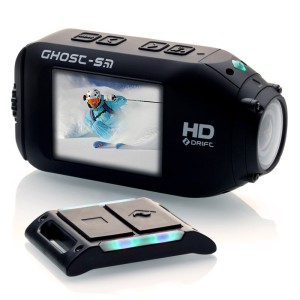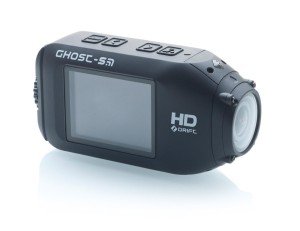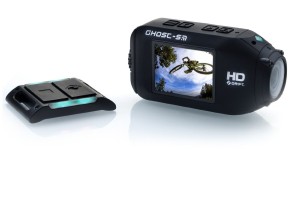Drift Ghost-S vs GoPro Hero 3+
With the action camera market growing significantly through 2013 and into 2014, a number of new players have entered the market and are competing for a slice of the pie which, so far, has been mainly eaten up by GoPro. One of these new players is Drift Innovations. While they have been making action cameras since 2009, the Drift Ghost-S is pitched directly against the GoPro in terms of spec and price. So how does it measure up?
 Externally, the Drift Ghost-S takes a similar approach to JVC’s Adixxion 2. The right side of the camera features a 2 inch screen to review footage, check the positioning of the camera and change the settings for the device. The back of the unit unscrews and opens up to reveal the memory card slot, battery and sockets for HDMI, USB and external microphone. The Drift Ghost-S also ships with a replacement back cover with rubber caps for these sockets for use in dry environments when you might want to pass a lead though. Up front there is a 160 degree wide angle lens which – borrowing a trick from the Contour range of cameras – is able to rotate through 300 degrees, allowing the footage to be made level even where the mounting point is not. The camera is covered in a slightly rubbery, soft touch material which makes it easy to grip, even when wet. It should be noted though that the Ghost-S is considerably heavier than the GoPro – almost double the weight in fact.
Externally, the Drift Ghost-S takes a similar approach to JVC’s Adixxion 2. The right side of the camera features a 2 inch screen to review footage, check the positioning of the camera and change the settings for the device. The back of the unit unscrews and opens up to reveal the memory card slot, battery and sockets for HDMI, USB and external microphone. The Drift Ghost-S also ships with a replacement back cover with rubber caps for these sockets for use in dry environments when you might want to pass a lead though. Up front there is a 160 degree wide angle lens which – borrowing a trick from the Contour range of cameras – is able to rotate through 300 degrees, allowing the footage to be made level even where the mounting point is not. The camera is covered in a slightly rubbery, soft touch material which makes it easy to grip, even when wet. It should be noted though that the Ghost-S is considerably heavier than the GoPro – almost double the weight in fact.
 The Drift Ghost-S also takes JVC’s approach to waterproofing. The entire unit is inherently waterproof to 3m (9 feet) without any need for a case. For nearly all on-land action sports, this level of protection will be absolutely fine – indeed, it is notably greater than that offered by the Contour+2, which is only weatherproof. However, for sustained use in an aquatic setting, we would always suggest a properly waterproof case – this is available from Drift Innovations, but adds around $50 to the price.
The Drift Ghost-S also takes JVC’s approach to waterproofing. The entire unit is inherently waterproof to 3m (9 feet) without any need for a case. For nearly all on-land action sports, this level of protection will be absolutely fine – indeed, it is notably greater than that offered by the Contour+2, which is only weatherproof. However, for sustained use in an aquatic setting, we would always suggest a properly waterproof case – this is available from Drift Innovations, but adds around $50 to the price.
As for mounts Drift Innovations sell a range of mounts that connect via a quick clip mechanism. However, the mount attachment on the camera is attached via a standard tripod mount point. As such, it is easily possible to use a variety of third party mounts as well, or instead of, Drift’s own offerings.
 As to recording modes, the Drift Ghost-S offers 1080p at 60 fps with a maximum field of view of 160 degrees – 127 and 90 degree field of view settings are also available at this resolution. Stepping down to 720p the maximum frame rate increases to 120fps, while 240fps is available at the non-HD WVGA setting. The 12 megapixel CMOS sensor can also capture a burst of 10 still photos. These specs put it on a par with the GoPro 3+ Silver, though the GoPro’s lens has a slightly wider field of view at 170 degrees. The Ghost-S also features a clever “video tagging” mode – in this, the camera records continuously, overwriting its own data on a continuous loop until you hit the “tag” button (when something exciting or funny happens) – the camera then saves the current loop for posterity and goes back into continuous loop mode. It’s a neat function, though recording all the time in this mode will obviously eat up the battery life more quickly.
As to recording modes, the Drift Ghost-S offers 1080p at 60 fps with a maximum field of view of 160 degrees – 127 and 90 degree field of view settings are also available at this resolution. Stepping down to 720p the maximum frame rate increases to 120fps, while 240fps is available at the non-HD WVGA setting. The 12 megapixel CMOS sensor can also capture a burst of 10 still photos. These specs put it on a par with the GoPro 3+ Silver, though the GoPro’s lens has a slightly wider field of view at 170 degrees. The Ghost-S also features a clever “video tagging” mode – in this, the camera records continuously, overwriting its own data on a continuous loop until you hit the “tag” button (when something exciting or funny happens) – the camera then saves the current loop for posterity and goes back into continuous loop mode. It’s a neat function, though recording all the time in this mode will obviously eat up the battery life more quickly.
Comparing the video footage of the GoPro Hero 3+ Silver and the Drift Ghost-S side by side, it is hard to pick one has being objectively “better” than the other, though there are differences. The GoPro has a slightly wider and more fisheyed lens, but the difference is small and less noticeable than with, for example, the JVC Adixxion 2. Some will want the ultra wide look that the GoPro provides; others will prefer the slightly less distorted field of view from the Ghost – it’s a pretty subjective issue, and it’s worth watching a few videos shot by each camera in order to make up your mind which camp you fall into!
 So in conclusion, does the Drift Ghost-S represent a serious competitor to the GoPro? In a word, yes. The video quality is right up there with the Hero 3+ Silver, and, leaving aside the price for the moment, the choice really boils down to which cameras features are more important to you. The external screen and rotatable lens are the key “extra” features for the Ghost, while the GoPro with its fully waterproof case as standard perhaps remain the choice for those looking to use it in an aquatic setting. The form factor is also an issue – some will prefer the shape of the Drift Ghost-S, which perhaps lends itself better to a side-of-helmet mounting position than the GoPro; on the other hand, the GoPro being shallower front-to-back works much better if (for example) used on a chest mount. In our view, the built in screen isn’t particularly important given that both cameras come with phone apps to access their settings and review footage.
So in conclusion, does the Drift Ghost-S represent a serious competitor to the GoPro? In a word, yes. The video quality is right up there with the Hero 3+ Silver, and, leaving aside the price for the moment, the choice really boils down to which cameras features are more important to you. The external screen and rotatable lens are the key “extra” features for the Ghost, while the GoPro with its fully waterproof case as standard perhaps remain the choice for those looking to use it in an aquatic setting. The form factor is also an issue – some will prefer the shape of the Drift Ghost-S, which perhaps lends itself better to a side-of-helmet mounting position than the GoPro; on the other hand, the GoPro being shallower front-to-back works much better if (for example) used on a chest mount. In our view, the built in screen isn’t particularly important given that both cameras come with phone apps to access their settings and review footage.
However, unless money is simply no object, we’ve got to consider price here as well. The Drift Ghost-S is currently around $400 – that’s fully $100 more than the best price for the GoPro Hero 3+ Silver at $300, and the same price as the range topping GoPro Hero 3+ Black edition. It has to be remembered that the GoPro black comprehensively beats the Ghost-S on spec, with a headline-grabbing 4K maximum resolution. All of the GoPro models also come with a waterproof case – this is arguably necessary for any serious water-based use, and yet for the Ghost-S its an additional $50. That makes the combination $450 – half as much again as the GoPro Hero 3+ Silver for a camera with basically the same video specs. It’s also worth remembering that the JVC Adixxon 2 is available for around $270, and also has broadly the same video specs, together with an LCD screen if that is important to you.
Overall then, we’d recommend the GoPro Hero 3+ Silver over the Drift Ghost-S on spec-for-the-price alone. However, if you take price out of the equation the Ghost-S remains a very compelling bit of kit.
Click here to check out the latest price for the Drift Ghost-S!
